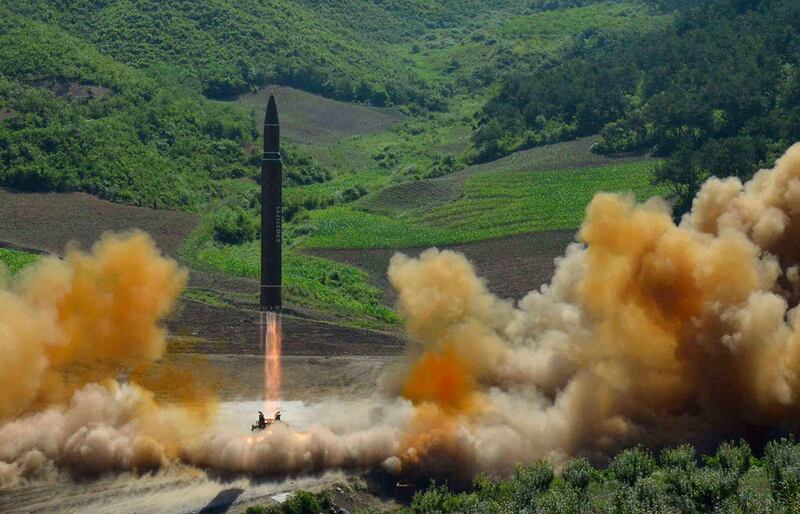Donald Trump's improvised and unconvincing threats about "fire and fury" and being "locked and loaded" notwithstanding, the crisis over North Korea's growing nuclear prowess and reach is all too serious. And the confrontation provides a template for how a dispute over Iran's analogous nuclear ambitions could play out in the future.
There are many important differences. Pyongyang is at least two decades ahead of Tehran in developing both nuclear warheads and missiles. North Korea has long since crossed the nuclear threshold. The argument now is over the scope and reach of their arsenal.
_______________
Read more:
[ World awaits next move between Trump and Kim Jong-un ]
[ Arms control expert: No good military option with North Korea ]
[ As the North Korean crisis deepens, Trump upends the nuclear calculus ]
_______________
North Korea has a powerful, albeit exasperated, patron in China. Iran does not.
Yet there are many similarities. North Korea has demonstrated that with determination and brazen persistence, even a mid-level, isolated power can go nuclear and that this produces a significant independent deterrence to much greater powers. North Korea provides a model for Iran for protecting regime security from external threats and gaining leverage with great powers, in contrast, for example, to the fate of Saddam Hussein's non-nuclear regime in Iraq.
Pyongyang and Tehran are both anti-status quo forces determined to reorder their regional environment to enhance their power and may be willing to go to almost any lengths to do so. Both are fanatical dictatorships, and potentially capable of self-destructive extremes – Pyongyang out of zealous nationalism and Tehran from religious millennialism.
The United States and the world order now confront a North Korean nuclear threat that is on the brink of going global, including intercontinental missiles capable of delivering warheads to much, if not all, of the American homeland.
Washington has four main options, singly or in combination: do nothing and rely on deterrence and mutually assured destruction; try to impose much tougher sanctions, preferably in coordination with China; negotiate, despite Pyongyang's lengthy track record of broken promises; or take military action.
It is the first and last of these that will be of most interest in Tehran. The biggest difference is that Iran has agreed to mothball its nuclear, though not missile, development, for ten years in exchange for sanctions relief. Mr Trump says he intends to hold Iran non-compliant with the agreement after the next US review in 70 days, but evidence suggests Iran is living up to its commitments.
How such an American move might play out is unclear, but for now, Tehran and its adversaries seem to have many years to measure their options.
_______________
More on North Korea:
[ Mattis tells North Korea: if you take on the US you will lose ]
[ America has run out of patience with North Korea ]
[ Watch: The Week That Was with Tim Marshall ]
_______________
What can Washington do in Korea? The military possibilities are not as limited as many think, although the risks are daunting. Last year, Washington was deploying new “left of launch” technologies, apparently mostly electronic disruption, designed to thwart missile launches before or during deployment. If these ever really worked, Pyongyang seems to have found a solution. Washington could shoot down future North Korean missile tests, but that would initiate an armed conflict in a very risky manner, ceding the initiative to Pyongyang.
Washington could try using conventional “bunker-buster” bombs to wipe out Pyongyang’s key assets.
Or, as suggested in a recent and highly controversial paper by scholars Keir A Lieber and Daryl G Press, Washington could use very low-yield, precisely targeted, tactical nuclear weapons to wipe out the major installations and small arsenal of an emerging nuclear power without producing much radioactive fallout or casualties far beyond that of a conventional strike. They argue that technological leaps in remote sensing and imaging, targeting accuracy and new cyber and data capabilities have quietly rendered such a nuclear counterforce strike an unexpectedly practicable option.
However, both conventional and nuclear counterforce options require that the target country doesn’t place key assets in urban areas, otherwise the likelihood of mass casualties returns. And they require the unlikely eventuality of virtual perfection in both intelligence and operations. If only one or two nuclear weapons survive, disaster would inevitably ensue.
Moreover, following any attack, North Korea is liable to unleash a vast and devastating conventional war with highly unpredictable consequences, including a massive assault on Seoul, a megalopolis of 25 million people. US rivals such as China and Russia, and even allies, such as South Korea and Japan, are likely to react with outrage if they are not party to any decision to act.
For now, Iran poses a much less serious conventional threat than North Korea, and its nuclear ambitions are both far behind Pyongyang's and on hold. But, if need be, Iran could already wreak havoc by attacking its neighbours, trying to close the Strait of Hormuz, and causing other chaos. Its non-nuclear capabilities may grow quickly, no matter what.
Eventually, Iran is likely to initiate the next major global crisis over an emerging, radical and highly destabilising nuclear power – especially if no solution to the present Korean stand-off short of sanctions and long-term deterrence emerges.
Therefore, Iran will meticulously scrutinise every detail of how this confrontation plays out. Tehran’s sense of how far it can go, what responses it can expect from Washington and the rest of the international community, and the options and limitations that a rising and radical new nuclear power must consider, will largely be shaped by what happens on the other side of Asia in the coming months.





